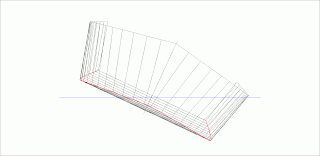 |
| Flint showing her V-bottomed hull-form |
 |
| A good example of a flat-bottomed sailing hull - this one is a Green Island 15 |
I've designed a number of V-bottomed hulls, but my main reason for using this form has been to gain stiffness in the bottom panels. The V-bottom picks up stiffness because the bottom is broken into two halves, and the keel line is very stiff indeed due to the convexity of the bottom in two directions - somewhat similar to the strength in an eggshell, which would break easily if a flat panel, but is extremely strong for its weight when in a compound, convex shape.
One method of reducing turbulence around the chine is to keep the chine out of the water altogether - both Jim Michalak and Phil Bolger have used this technique a number of times - but the problem with that is it generally works well only if the boat is a light displacement design intended to run on an even keel e.g. rowing boats and power boats.
When more displacement is required, I use a different approach. A good example for discussion is my Alby design, which is a short pram dinghy designed to be short, but able to carry a heavy load. She was designed for my friend, Allan Burke. In order to maximise the displacement (therefore increase the carrying capacity), I used a lot of keel rocker, and reduced the angle of the "V" in the bottom amidships to only about 3.5 degrees. However, in order to reduce pounding, I twisted the bottom panels to give a relatively sharp "V" at the waterline foreward and aft - 18 to 20 degrees of deadrise.
In the drawing above, you can see how the chine-line (drawn in red) sweeps down strongly from the bow and stern to the lowest point amidships. The resulting hull is almost flat-bottomed amidships but quite well V'd at the bow and stern. I could have made her totally flat in the middle, but I left enough "V" to give the "eggshell" stiffness of a convex shape.
Some people will tell you that running a chine deeply into the water will cause excess turbulence and drag, but that is only the case if the hull is incorrectly shaped in 3D. You must consider a boat shape in profile, plan and body plan (i.e. end elevation) to get some idea of how the water will flow.
Above you can see the same hull viewed in body-plan . See how the designed curve in the topside panels and the bottom panels has resulted in a clean and well-streamlined chine-line (drawn in red)?
Now look at the same hull heeled at 20 degrees. The chine-line is forming a beautiful "V" with very little to cause turbulence, or to hold the boat back. This is one of the primary reasons why a well-designed pram or scow can be so fast - particularly in flat water.
 |
| This may give a clearer idea of how well the shape will slip along with minimal turbulence. |
 |
| Mirror 16 showing chine-line. (courtesy Terence, Boatdesign.net) |
These are just my own thoughts, but I'm sticking with them at this stage.






No comments:
Post a Comment